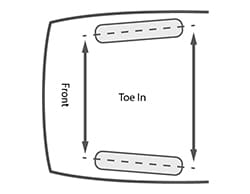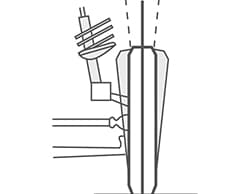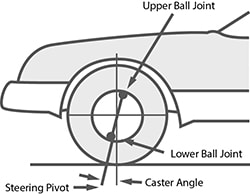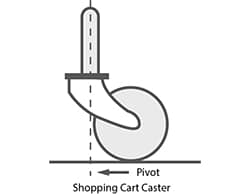4 Wheel Alignment
Customers often under estimate the importance of wheel alignment.With this latest investment in technology Ricci Concept can be sure of precision wheel alignment.The Beissbarth 4-wheel alignment machine uses the latest laser technology to measure and correct wheel alignment.
Incorrect wheel alignment causes:
- Excessive and uneven tyre wear
- Out of alignment steering wheel
- Steering wheel vibration
- Poor handling
- Instability under braking
- Higher fuel consumption
- Car pulls to one side
Correct wheel alignment will deliver savings in terms of tyre life and fuel economy.
It is important to carry out wheel alignment if your vehicle shows any of the above symptoms or after suspension work or lowering your car.
Our Beissbarth wheel alignment machine is approved by AUDI, VW and PORSCHE and offers a high degree of accuracy. The aligner is able to measure vehicle with wheel sizes up to 24″ diameter.
We are able to identify faults in the steering geometry and identify worn suspension parts.
All data is recorded and compared to the manufacturer’s specifications and the final result can be printed out.
We also point out the importance of resetting the wheel alignment after lowering a vehicle
For Advice or to Book your vehicle in for a 4 wheel alignment check. Please contact us on 01482 322446
What is the difference between Tracking and Four Wheel Alignment?
Tracking is an across the axle check of total toe only. With the tracking gauges touching the edge of the wheel rim the operator peers through a ‘scope’ or views a light/laser beam on a scale. With no allowance for run out compensation* the reading taken will at best be approximate. So for tracking – we have one angle measured approximately.
Four wheel alignment will give a minimum of 12 angles measured, all referenced to the car wheel centreline* and displaying these alignment angles and comparing them to the factory wheel alignment data. Allowance is made for wheel rim run-out. We have accurate repeatable reading that will allow the full picture of how the vehicle drives and whether undue tyre wear will occur. Adjustment would involve the steering wheel being set straight and adjusting the individual toe to maintain a straight steering wheel while the car is driven. On a modern vehicles tracking alone will not result in a complete job or your complete satisfaction.
After Severe Winter Road conditions – a 4-wheel Alignment check is a must!
After one of the most severe winters seen for some time, drivers are now looking forward to spring, for some good motoring. But, before you do, you need to be aware of toll this winter has had on your car, and may still have in the weeks and months ahead!

Toe-in
The toe measurement is the difference in the distance between the front of the tyres and the back of the tyres on one axle. It is measured in fractions of a degree and is usually set close to zero which means that the wheels are parallel with each other. Toe-in means that the fronts of the tyres are closer to each other than the rears. Toe-out is just the opposite. An incorrect toe-in will cause rapid tyre wear to both tyres equally. If there is more wear on the inner edges of the tread section this may indicate there is too much toe-out. If there is more wear on the outer edges of the tread section this may indicate there is too much toe-in. Toe is always adjustable on the front wheels and on some cars, is also adjustable for the rear wheels.

Camber
Camber is the angle of the wheel in relation to the ground measured in degrees, when viewed from the front of the vehicle. If the top of the wheel is leaning out from the center of the car then the camber is positive, if it’s leaning in, then the camber is negative. If the camber is out of adjustment, it will cause wear on one side of the tyre’s tread. If the camber is too far negative, for instance, then the tyre will wear on the inside of the tread.
If the camber is different from side to side the vehicle will pull to the side with the more positive camber. On many front-wheel-drive vehicles, camber is not adjustable. If the camber is out on these cars, it indicates that something is worn or bent, possibly from an accident and must be repaired or replaced.

Caster
When you turn the steering wheel, the front wheels respond by turning on a pivot attached to the suspension system. Caster is the angle of this steering pivot, measured in degrees, when viewed from the side of the vehicle. If the top of the pivot is leaning toward the rear of the car, then the caster is positive, if it is leaning toward the front, it is negative. If the caster is out of adjustment, it can cause problems in straight line tracking. If the caster is different from side to side, the vehicle will pull to the side with the less positive caster. If the caster is equal but too negative, the steering will be light and the vehicle will wander and be difficult to keep in a straight line. If the caster is equal but too positive, the steering will be heavy and the steering wheel may kick when you hit a bump. Caster has little effect on tire wear.
The best way to visualize caster is to picture a shopping trolley caster. The pivot of this type of caster, while not at an angle, intersects the ground ahead of the wheel contact patch. When the wheel is behind the pivot at the point where it contacts the ground, it is in positive caster. Picture yourself trying to push the cart and keep the wheel ahead of the pivot. The wheel will continually try to turn from straight ahead. That is what happens when a car has the caster set too far negative. Like camber, on many front-wheel-drive vehicles, caster is not adjustable. If the caster is out on these cars, it indicates that something is worn or bent, possibly from an accident, and must be repaired or replaced.



